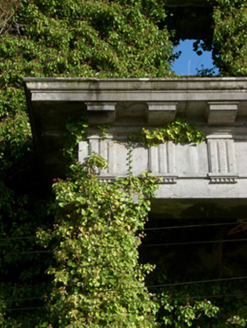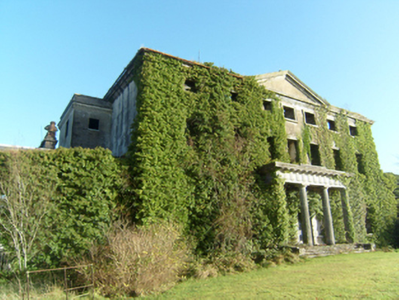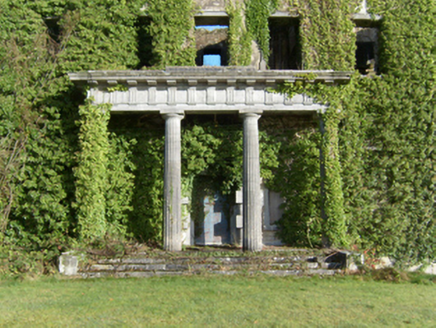Survey Data
Reg No
30406012
Rating
Regional
Categories of Special Interest
Architectural, Artistic
Original Use
Country house
Date
1780 - 1870
Coordinates
174594, 239415
Date Recorded
10/11/2009
Date Updated
--/--/--
Description
Detached eight-bay three-storey over basement country house, built c.1790, now ruined, having square plan with three-bay pedimented breakfront, Doric entrance porch added c.1824, three-storey over basement single-bay extension with parapet roof and brick cornice to north-west, single-storey bow-ended wing to south-east added c.1855, and two-storey wing to north-west. Ruled and lined lime rendered façade. Porch, accessed by four stone steps, has carved stone entablature with triglyph and metope detail and moulded cornice with dentils above, supported on four fluted Doric columns. Remains of two pairs of rendered chimneystacks to centre of plan, brick chimneystack to north-west wing, moulded cornice at eaves, cast-iron rainwater goods. Square-headed window openings with tooled limestone sills and moulded shouldered limestone surrounds, remains of six-over-six pane timber sliding sash windows to rear. Double-leaf timber entrance door with lancet-patterned fanlight above, fluted entablature and column and block limestone surround with patera motif. Set in own extensive grounds with two-storey rendered outbuildings forming a courtyard to rear, one of which in use as private dwelling.
Appraisal
Clonbrock was designed by William Leeson for Robert Dillon, the 3rd Baron Clonbrock, and constructed from 1780-1788 to replace the old castle which stood on the site. Unusually, it remained in the possession of the Dillon family for almost 200 years. Sold in 1976 when the last member of the Clonbrock family, Miss Ethel Dillon, moved out, the contents of the house were auctioned off. The National Library of Ireland acquired the estate papers in the auction, a valuable insight into the management of a large Irish country house. A fire blazed through the house in 1984, destroying the intricately detailed interior. Though now ruined, this imposing country house retains its sense of grandeur and the high level of design and craftsmanship is evident in the remaining fabric, such as the ornate entrance porch and the finely tooled stone window surrounds. It is an important part of the social and architectural heritage of the area.





